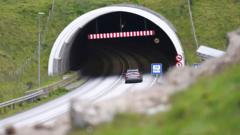As Shetland looks for ways to enhance transport and economic opportunities, they're taking a cue from the Faroe Islands, which boasts an impressive network of undersea tunnels. The Prime Minister of the Faroes, Aksel Johannesen, recently highlighted how these tunnels have revitalized his country's economy and communities. With 23 tunnels, including four that lie beneath the sea, the Faroes have seen growth in both population and business.
Shetland Islands Council is now pushing forward with plans to link four isolated islands, including Unst—Britain's most northerly point. They aim to fund these tunnels through borrowing, with user tolls poised to provide a sustainable transport alternative. Critics of current ferry services argue that Scotland has lagged behind, while the successful Faroese model emphasizes timely investment in infrastructure.
One local business leader, Anne Anderson, noted that Scottish salmon producers face increasing market competition partly due to infrastructural shortcomings. Many believe that emulating the Faroese strategy could help rejuvenate local industries and prevent further market share loss.
In the Faroes, the tunneling system has been in continuous development since the 1960s, greatly enhancing travel times and community engagement. A bold example is the undersea roundabout connecting Streymoy and Eysturoy, which has streamlined travel and reduced congestion.
Advocates in Shetland see a similar potential, with local government leaders emphasizing the need to modernize transportation options. As the council launches a feasibility study, they hope to attract economic investment to the region and possibly even new spaceport ventures.
While discussions on ferry services remain ongoing, the future of transportation in Shetland may well hinge on their ability to learn from the Faroese success. With plans gaining momentum and local enthusiasm growing, the prospect of creating connecting tunnels could be a game changer for the islands. The benefits of the infrastructural shift offer a vision for thriving island communities fully integrated into the global economy.
Shetland Islands Council is now pushing forward with plans to link four isolated islands, including Unst—Britain's most northerly point. They aim to fund these tunnels through borrowing, with user tolls poised to provide a sustainable transport alternative. Critics of current ferry services argue that Scotland has lagged behind, while the successful Faroese model emphasizes timely investment in infrastructure.
One local business leader, Anne Anderson, noted that Scottish salmon producers face increasing market competition partly due to infrastructural shortcomings. Many believe that emulating the Faroese strategy could help rejuvenate local industries and prevent further market share loss.
In the Faroes, the tunneling system has been in continuous development since the 1960s, greatly enhancing travel times and community engagement. A bold example is the undersea roundabout connecting Streymoy and Eysturoy, which has streamlined travel and reduced congestion.
Advocates in Shetland see a similar potential, with local government leaders emphasizing the need to modernize transportation options. As the council launches a feasibility study, they hope to attract economic investment to the region and possibly even new spaceport ventures.
While discussions on ferry services remain ongoing, the future of transportation in Shetland may well hinge on their ability to learn from the Faroese success. With plans gaining momentum and local enthusiasm growing, the prospect of creating connecting tunnels could be a game changer for the islands. The benefits of the infrastructural shift offer a vision for thriving island communities fully integrated into the global economy.




















